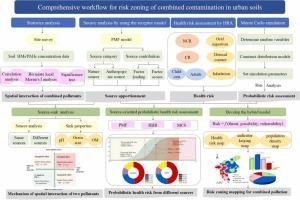当前位置:
X-MOL 学术
›
J. Hazard. Mater.
›
论文详情
Our official English website, www.x-mol.net, welcomes your
feedback! (Note: you will need to create a separate account there.)
A spatial source-oriented and probability-based risk-assessment framework for heavy metal and PAH contamination of urban soils in Guangzhou, China
Journal of Hazardous Materials ( IF 12.2 ) Pub Date : 2024-11-13 , DOI: 10.1016/j.jhazmat.2024.136500 Lian Chen, Minghe Xie, Gaocong Li, Sen Lin, Dan Wang, Zhiyi Li, Yuan Wang, Zhenjiang Wang
Journal of Hazardous Materials ( IF 12.2 ) Pub Date : 2024-11-13 , DOI: 10.1016/j.jhazmat.2024.136500 Lian Chen, Minghe Xie, Gaocong Li, Sen Lin, Dan Wang, Zhiyi Li, Yuan Wang, Zhenjiang Wang

|
The identification and quantification of high-risk hotspots for soils contaminated by heavy metals (HMs) and polycyclic aromatic hydrocarbons (PAHs) remains a challenge due to their various sources and heterogeneous sink properties in urban soil systems. In this study of 221 soil samples from Guangzhou, China, a novel framework combining Bivariate local Moran’s I (BLMI), positive matrix factorization (PMF), human health risk (HHR) assessment, Monte Carlo simulation (MCS), and a newly developed spatial risk model were proposed to conduct probabilistic source-oriented HHR assessment, high-risk hotspot quantification, and risk formation mechanism elaboration. Study results indicate that traffic emissions are the largest contributor of HMs (47.6%) and PAHs (40.2%), but not always the largest contributor of HHR. Agricultural or urban green-space management activities of HM, and mixed source of PAH, are the largest contributors of non-carcinogenic risk (NCR, 48.7% and 51.1%, respectively), while mixed source of HM and traffic emissions of PAH are the largest contributors of carcinogenic risk (CR, 53.9% and 71.2%, respectively). The probability of risk exceeding safe threshold levels is <5.0% for NCR and >90.0% for CR. High-risk hotspots were identified in the mid-west and south of the city, making up 15.0% of the total Guangzhou area. Risk mechanisms were deduced from the spatial heterogeneity and inter-dependence of emission sources and soil sink, based on source–sink theory. Our findings provide a new framework for precisely identifying risk sources and target areas, thereby alleviating HHR associated with co-occurring HMs and PAHs in urban soil systems.
更新日期:2024-11-13


















































 京公网安备 11010802027423号
京公网安备 11010802027423号